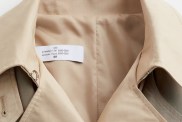Freelance photographer Dave Wheeler, knows firsthand how quickly the fashion industry can shift, having witnessed the explosion of digital media and successfully ridden the wave of a constantly evolving industry.
As part of our series with AustralianSuper, helping you kick start your creative career, Dave runs us through the main differences between shooting for print and online and how you can master both!
With the recent shift from print media being the main playground for photography to online being boss, there’s a few extra things you need to consider when you’re working. For example, shooting for online publications means working with different colour spaces, whilst working for print media will need you to consider page bleeds, not to mention how online can mean needing to introduce new digital aspects into your work.
Colour Space:
There’s a difference between the colour profiles used for printed images, and those destined for the web. Your camera will most likely let you choose between capturing in Adobe RGB, or sRGB, and these are the two main profiles you’ll need to deal with.
PRINT: Always use Adobe RGB, and make sure it’s set in the camera, not converted later in a program like Photoshop. Adobe RGB colour profile covers more colours, so to try turn an sRGB to Adobe RGB later will mean Photoshop is having to guess and insert colours itself.
ONLINE: sRGB will match how it looks on most people’s monitors, so convert your images to this format after working on them. It will mean a smaller file size and more accurate colours.

Campaign for Vogue Australia magazine, shot by Dave Wheeler.
Page bleeds:
When you’re shooting a full page shot for a magazine, you need to consider page bleed. Printers need a little extra room to allow for binding, trimming and other things.
PRINT: Give yourself a little extra room in your crop to give a slightly bigger shot to the client. They can then crop in to how you want it later.
ONLINE: There’s no bleed online so you can crop your image without needing extra space around the edges. Websites can often have much wider crop dimensions for their layouts, so always check with your client how and where the image will be used.

Another print campaign by Dave Wheeler for Women’s Fitness magazine.
Emerging Technologies
One final trend to keep an eye on is the use of emerging technologies in online media. Lots of online publications utilise gifs and cinemagraphs to bring their images to life. Both are worth reading up on and experimenting with, as lots of clients will love you bringing new ideas to the table.

An example of a fashion cinemagraph by photographer Anne Street.
Dave Wheeler is a freelance fashion photographer based in Sydney. You can find out more about him on his website.
If you’re just starting out in your career, a few right moves early on can help set you up for life. For more stories in our AustralianSuper KickStart series, click here or go to AustralianSuper.
This article has been sponsored by AustralianSuper Pty Ltd ABN 94 006 457 987, AFSL 233788. The views and opinions expressed in any article accessed through theFashionSpot are those of the author or theFashionSpot and not the responsibility of AustralianSuper. For more information, please visit australiansuper.com



